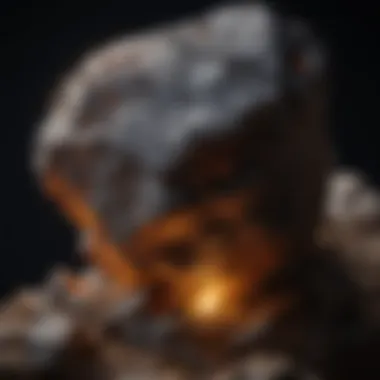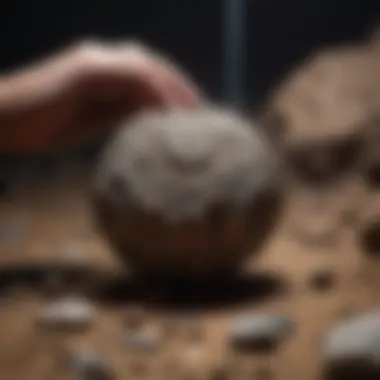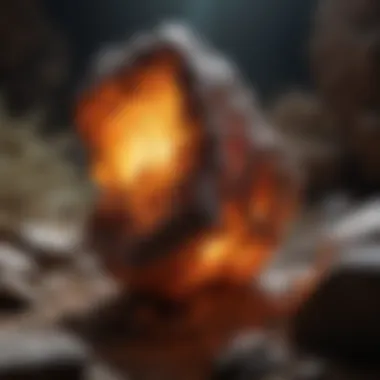Unveiling the Advantages of a 51 LED UV Flashlight for Rock and Fossil Enthusiasts


Rock and Fossil Identification
When delving into the realm of rock and fossil collecting, a crucial aspect that enthusiasts must master is the identification of different specimens. Various types of rocks and fossils exist, each with unique characteristics and properties. Rock collectors often seek out specimens ranging from sedimentary rocks like limestone and sandstone to igneous rocks such as granite and basalt, while fossil enthusiasts eagerly hunt for remnants of ancient life forms like trilobites or ammonites. To accurately identify these geological treasures, collectors must pay attention to specific features that distinguish one type from another. Whether it's the color, texture, crystal structure, or fossil imprints, the subtle distinctions hold the key to classification.
Collecting Tips and Techniques
Efficient collection methods are paramount for rock and fossil enthusiasts to build a remarkable collection. To excel in this pursuit, individuals must adopt best practices that encompass ethical and practical considerations. When heading out to explore collecting sites, it's essential to conduct thorough research to locate prime spots with high specimen concentrations. Moreover, understanding how to safely extract specimens without damaging them or their surrounding geological context is crucial. Techniques ranging from gentle chiseling to delicate brushing ensure that specimens are retrieved intact and ready for further examination.
Preservation and Display
Preserving collected rocks and fossils is a fundamental aspect of the hobby, ensuring that specimens maintain their integrity and value over time. Various preservation techniques exist, such as consolidating fragile rocks with adhesives or applying protective coatings to fossils to prevent deterioration. Additionally, selecting appropriate storage methods is essential to shield specimens from damage caused by environmental factors like humidity or sunlight. When it comes to displaying treasures from your collection, creativity knows no bounds. From custom-built shelving units to thematic arrangements, the presentation of rocks and fossils can elevate their beauty and educational value.
Geological Insights
Beyond the thrill of collecting, rocks and fossils offer profound insights into the Earth's history and geological processes. Studying geological formations illuminates the forces that have shaped our planet over millions of years, from the gradual formation of sedimentary layers to the cataclysmic upheavals that created mountain ranges. Moreover, rocks and fossils hold immense historical significance, offering glimpses into past ecosystems and evolutionary pathways. Notable discoveries in the field continue to enrich our understanding of Earth's rich geological tapestry, uncovering hidden chapters of our planet's story.
Introduction
In delvig deeper into the benefits of a 51 LED UV flashlight for rock and fossil collectors, one can grasp the essence of this unique tool in enhancing the exploration of geological treasures. The intricacies involved in understanding the technology behind UV flashlights, the advantages brought by LED technology, and the specific features of the 51 LED UV flashlight model all play a pivotal role in transforming the collecting experience.
Overview of LED UV Flashlights
Understanding the technology behind UV flashlights
The underlying concept of UV flashlights sets them apart in the world of illumination tools. By harnessing ultraviolet light wavelengths, these flashlights have the capability to unveil hidden fluorescences and details that often escape the naked eye. This technology revolutionizes the way collectors engage with their specimens, allowing for a deeper understanding of geological formations.
Exploring the benefits of LED technology in flashlights
LED technology brings a plethora of benefits to the realm of flashlights. From energy efficiency to longevity, LED lights are a popular choice for their durability and brightness. By incorporating LED technology into UV flashlights, collectors can enjoy a reliable light source that enhances visibility and ensures consistent performance during expeditions.
Introduction to the LED UV flashlight model
The 51 LED UV flashlight model stands out as a beacon of innovation in the collector's toolkit. With its compact design, sturdy construction, and long-lasting LED bulbs, this model offers a blend of portability, durability, and functionality. Collectors can rely on this model to illuminate their collections effectively and uncover hidden details with ease.
Significance for Rock and Fossil Collectors


Enhancing visibility of fluorescent minerals
By utilizing a 51 LED UV flashlight, collectors can bring out the vibrant fluorescent hues of minerals that are otherwise invisible under normal lighting conditions. This heightened visibility allows for better appreciation of the mineral's natural beauty and unique characteristics, enriching the collecting experience.
Detecting authenticity and characteristics of fossils
In the realm of fossil collection, authenticity is paramount. The UV light emitted by the flashlight aids collectors in identifying genuine fossils from replicas by revealing distinct patterns and characteristics that may be obscured under regular light. This feature ensures that collectors build authentic and valuable collections.
Identifying hidden patterns and markings on rocks
Rocks hold a myriad of intricate patterns and markings that tell the story of their formation. With the aid of a 51 LED UV flashlight, collectors can unveil these hidden details, uncovering the geological history encapsulated within each rock. This in-depth exploration enriches the understanding of rock formations and their significance.
Impact on Geological Exploration
Utilizing UV light in field expeditions
Field expeditions necessitate tools that are reliable and versatile. The integration of UV light in these expeditions opens up new possibilities for exploring geological specimens in their natural habitat. From caves to mountain ridges, collectors can utilize UV light to enhance their observations and analyses, leading to a more comprehensive understanding of geological formations.
Examining specimens in various geological settings
The 51 LED UV flashlight enables collectors to examine specimens across diverse geological settings, from deserts to riverbeds, with precision and clarity. This adaptability ensures that collectors can study specimens in their natural environment without compromising visibility or accuracy, enhancing the overall exploration process.
Uncovering hidden details in geological formations
Geological formations hold layers of concealed details that can only be brought to light with the aid of UV technology. By utilizing the 51 LED UV flashlight, collectors can uncover these hidden details, such as mineral veins and fossil imprints, that provide valuable insights into the geological history of an area. This in-depth analysis enriches the exploration of geological formations and fosters a deeper connection with the natural world.
Advantages of LED UV Flashlight
In this article, the significance of the 51 LED UV flashlight is paramount to understand the practical benefits it offers to rock and fossil collectors. The utilization of LED technology in flashlights has revolutionized the way collectors explore geological specimens. The 51 LED UV model, in particular, combines efficiency with portability, making it an indispensable tool for enthusiasts in the field. Its compact design allows for easy transportation, ensuring that collectors can carry it effortlessly during field expeditions. The sturdiness of its construction adds a layer of durability, ideal for outdoor use where rugged terrains may be encountered. Additionally, the longevity of the LED bulbs ensures a reliable light source that lasts, minimizing the need for frequent replacements and enhancing the user experience over time.
Portability and Durability
Compact design for easy transportation
The compact design of the 51 LED UV flashlight stands out as a key feature that resonates with collectors. Its lightweight nature and streamlined structure make it a convenient companion for expeditions, fitting easily into backpacks or pockets without adding unnecessary bulk. The portability it offers enables collectors to move swiftly through varied geological settings without being encumbered by heavy equipment, ultimately enhancing their exploration experience. Despite its diminutive size, the compact design does not compromise on functionality, showcasing the balance between practicality and performance that collectors seek in their tools.


Sturdy construction for outdoor use
The sturdy construction of the flashlight is tailored for outdoor environments, where durability is a crucial factor. Designed to withstand rough handling and harsh conditions, the flashlight's robust build ensures reliability in challenging terrains. Its resilience against impacts and elements safeguards the internal components, maintaining consistent performance even in adverse weather conditions or rugged landscapes. This feature amplifies the utility of the flashlight, making it a trusted companion for collectors venturing into the field in search of geological marvels.
Longevity of LED bulbs
The longevity of the LED bulbs in the 51 LED UV flashlight is a defining characteristic that sets it apart from traditional lighting sources. LED technology offers extended lifespan compared to conventional bulbs, ensuring continuous illumination during prolonged use. By lasting longer and consuming lesser energy, LED bulbs reduce the frequency of battery replacements, enhancing the sustainability of the flashlight. This longevity contributes to the overall efficiency of the tool, providing collectors with a reliable light source that endures through extended observations and examinations of geological specimens.
Practical Uses in Collection Management
In the realm of rock and fossil collecting, the section on Practical Uses in Collection Management is of paramount importance. It serves as a guiding light for enthusiasts, offering a structured approach to organizing and maintaining their collections effectively. For rock and fossil collectors embarking on their journey, understanding how to identify, classify, and preserve their specimens is crucial. Practical Uses in Collection Management delves into the meticulous tasks of mineral identification, fossil examination, and innovative ways to enhance display and presentation.
Mineral Identification and Classification
Highlighting fluorescent properties of minerals
Within the domain of Mineral Identification and Classification, highlighting fluorescent properties of minerals takes center stage. This aspect unveils the hidden vibrancy of various minerals under UV light, allowing collectors to appreciate the distinctive glow emitted by fluorescent specimens. The key advantage of this process lies in its ability to differentiate between minerals based on their fluorescence patterns, aiding in accurate classification. Despite its remarkable benefits, some collectors may find the reliance on UV light slightly cumbersome in certain lighting conditions.
Distinguishing between mineral types and compositions
Another crucial facet of Mineral Identification and Classification involves distinguishing between mineral types and compositions. By examining the unique characteristics and structural properties of minerals, collectors can pinpoint subtle differences that determine their mineralogical features. This method aids in creating a systematic approach to categorizing minerals based on their distinct compositions, enhancing the overall classification process. However, the intricate nature of mineral composition analysis may pose challenges for novice collectors seeking to master this skill.
Cataloging and organizing mineral specimens
Cataloging and organizing mineral specimens form the backbone of effective collection management. This aspect emphasizes the significance of maintaining detailed records and systematic arrangements to facilitate easy retrieval and reference. By meticulously cataloging specimens based on their geological properties and origins, collectors can create a comprehensive database that streamlines their exploration and study. While the organizational benefits are substantial, the meticulous nature of cataloging may require patience and attention to detail from collectors.
Fossil Examination and Preservation
In the domain of Fossil Examination and Preservation, collectors delve into deciphering the mysteries encased within ancient remnants of the past. By unveiling hidden details on fossil surfaces, assessing integrity and quality, and safeguarding fossils from damage, collectors embark on a journey of discovery and preservation.
Revealing hidden details on fossil surfaces
Revealing hidden details on fossil surfaces sheds light on the intricate imprints and textures preserved over time. This process enables collectors to unravel the story captured within fossilized remains, offering insights into prehistoric eras and geological transformations. Through meticulous examination under UV light, collectors can unveil intricate details that might escape the naked eye, enhancing their understanding of fossil structures. However, the reliance on specialized equipment for detailed examination may pose challenges in field settings.
Assessing fossil integrity and quality


Assessing fossil integrity and quality plays a crucial role in determining the value and authenticity of fossil specimens. By evaluating the structural stability and overall condition of fossils, collectors gain valuable insights into the preservation methods and environmental factors influencing fossil longevity. This process aids in differentiating between genuine artifacts and replicas, ensuring that collectors acquire specimens of significant scientific and aesthetic value. Despite its importance, meticulous inspection of fossil integrity demands a keen eye for detail and expertise in fossil analysis.
Protecting fossils from damage during handling
Protecting fossils from damage during handling requires a delicate balance between preserving fragile specimens and ensuring safe transportation. Collectors must exercise caution and precision when engaging with delicate fossils to prevent accidental breakage or deterioration. By employing suitable handling techniques and protective measures, collectors can safeguard their treasured specimens for future generations to admire. While protection measures are indispensable, collectors need to prioritize conservation practices without compromising the accessibility of fossils for study and display.
Enhancing Display and Presentation
Enhancing Display and Presentation elevates the immersive experience of showcasing geological wonders to diverse audiences. By creating captivating visual displays of collections, showcasing fluorescence in museum exhibitions, and utilizing UV effects in educational settings, collectors unveil the mesmerizing beauty of their curated artifacts.
Creating captivating visual displays of collections
Creating captivating visual displays of collections transforms ordinary showcases into exhibition masterpieces. By incorporating creative lighting techniques and strategic arrangements, collectors can captivate viewers with the stunning diversity of minerals and fossils. This approach enhances the storytelling aspect of collections, weaving narratives that transcend time and geographical boundaries. Despite its awe-inspiring impact, creating visually appealing displays requires meticulous planning and design execution.
Showcasing fluorescence in museum exhibitions
Showcasing fluorescence in museum exhibitions brings a dynamic dimension to conventional displays by accentuating the natural radiance of minerals under UV light. This interactive showcase engages visitors in an immersive exploration of fluorescence, highlighting the beauty of minerals in a surreal luminescent display. The allure of showcasing fluorescence lies in its ability to unveil the hidden splendor of minerals, offering a visual feast for museum attendees. However, implementing UV lighting solutions in exhibitions may necessitate technical expertise and careful calibration for optimal effect.
Utilizing UV effects in educational purposes
Utilizing UV effects in educational purposes transcends traditional teaching methods, providing a novel approach to engaging students in the wonders of geology. By integrating UV technology into educational initiatives, instructors can illuminate the scientific principles behind mineral fluorescence and geological phenomena. This hands-on learning experience fosters a deeper appreciation for Earth's geological diversity, inspiring curiosity and exploration among students. Despite its educational benefits, incorporating UV effects into curricula requires thoughtful integration and comprehensive understanding of UV technology's applications.
Overall, the Practical Uses in Collection Management section encapsulates the essence of rock and fossil collecting as a meticulous journey of exploration, preservation, and presentation. By delving into the intricate processes of mineral identification, fossil examination, and creative display techniques, collectors unlock the hidden wonders of the Earth's geological heritage.
Conclusion
The conclusion section of this article serves as a pivotal point encapsulating the essence and significance of the discussion on the benefits of a 51 LED UV flashlight for rock and fossil collectors. Through a meticulous analysis of the various applications and advantages of this innovative tool in the realm of geological exploration, a profound understanding of its role in enhancing the collector's experience is elucidated. Emphasizing the practicality and efficiency of the 51 LED UV flashlight, this section aims to underscore the profound impact it can have on not just the identification and examination of geological specimens, but also in the broader context of geological research. By synthesizing key insights from the preceding sections, this conclusion acts as a comprehensive guide for collectors looking to leverage the capabilities of this remarkable device in their pursuits.
Key Takeaways
The versatility of LED UV flashlight for collectors
The versatility of the 51 LED UV flashlight for collectors is a pivotal aspect discussed throughout this article. Its remarkable adaptability to different geological specimens, coupled with its unparalleled efficiency in mineral identification and fluorescence, make it a standout choice for collectors seeking a multifaceted tool. The ease of use and maintenance of this flashlight further enhance its appeal, catering to collectors of all levels. Despite its numerous advantages, a minor drawback worth noting is its reliance on battery power, requiring occasional replacement or charging to ensure uninterrupted usage.
Enhanced viewing and identification capabilities
Delving into the enhanced viewing and identification capabilities of the 51 LED UV flashlight reveals a transformative aspect of its utility. By illuminating fluorescent properties of minerals and facilitating the distinction between mineral types and compositions, this tool elevates the collector's ability to categorize and organize their specimens effectively. The superior viewing experience it provides, especially in museum exhibitions where fluorescence can be showcased brilliantly, underscores its value in enhancing the aesthetic appeal and visual impact of geological collections.
Integration of UV technology in geological research
The integration of UV technology in geological research, as exemplified by the 51 LED UV flashlight, demonstrates a cutting-edge approach to specimen examination and data collection. Its ability to uncover hidden details in geological formations and aid in field expeditions offers researchers a valuable tool for in-depth analysis and exploration. While its contribution to geological research is undeniable, the limited range of UV light coverage may pose challenges in certain settings, requiring supplementary lighting sources for comprehensive investigations.







